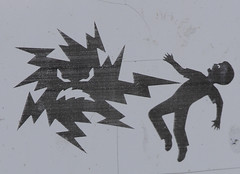 |
| Angry Cloud (Photo credit: Kairon Gnothi (Opportunity Knocks)) |
Brain Chemistry and Anger
Anger control is best understood through thinking about the brain chemistry involved. I teach this to children to give them a good understanding of exactly what is happening. We often think of emotions as something that happens which is out of our control. In actuality, we have a lot of control over our emotions if we can learn to harness our mental power and rational thinking.Close your hand in a fist with the thumb hidden by the other four fingers. The fist represents the brain and the wrist and and forearm are the spinal cord. The lower part of the brain connected to the spinal cord is the brainstem. It controls instinctive behavior and involuntary functions such as breathing and heart rate. The thumb represents the midbrain where emotions and memories are created and processed. The back of the hand and the fingernails represent the cerebral cortex. It controls logical thinking and causes us to act with kindness and empathy. Our reasoning and problem solving abilities reside here. Communication travels from one section of the brain to another section.
What happens when someone loses control of their emotions? What was happening to the student who was hysterical with rage? A good way to illustrate this is by suddenly opening up the fingers, leaving the thumb still crossed in the palm of the hand. We might say this represents a time when someone has "flipped their lid." Notice how far away the logical part of the brain (the part represented by the fingernails) is now from the emotions in the thumb? Of course our brain doesn't actually shift but our thinking does. Since many students are very literal I always make sure they understand that their brain doesn't actually flop around like a fish out of water. But our thinking becomes inflamatory. We might think, "This is the worst day of my life!!! Wally the meanest boy in the world has embarrassed me and I'll never live it down." Irrational thinking usually involves catastrophic thinking with lots of absolutes and exaggerations such as: "always", "never", "worst day of my life", "I'll never".
The First Step to Regaining Control: Belly Breathing
The first step in regaining control and getting the emotional part of the brain back in touch with the rational thinking part is to practice some controlled breathing. Here's a great video of the Sesame Street Characters teaching belly breathing:Breathing can help a child become calm enough to engage in some therapeutic talk that can change irrational thinking to rational thinking. Focusing on breathing is a great way to refocus both our physical and our mental bodies.
The Second Step: Changing Irrational Thinking
Once calm, the next step is to challenge the irrational thinking and replace it with rational problem solving thinking. What really happened? Is there a different perspective that would help to solve the problem? What needs to happen next to resolve the issue? These are some of the questions that can be asked to turn an angry situation into a calmer interaction. It's also important to rephrase or restate the situation in a way that is reasonable but more manageble and not so inflammatory. For instance, " Wally said something mean that hurt my feelings. I need to let him know that I don't like it when he does that."The Third Step: Make a Plan
It's always good to learn from past experience and I usually end by encouraging the child to make a plan for the future. What if Wally continues to say mean things? What are the options? What can the child do or say?Great Books for Children on Anger
Looking for some great books to help a child learn more about handling anger? Check out these that are all recommended by Barbara a terrific school counselor in Friendswood, Texas. The Corner on CharacterWhat do you do to handle anger either in yourself or in children? I'd love to hear your comments?
Like this post? Share with friends on facebook and twitter!!


Lynne thank you so much for this insight! My young son who is normally kind and sweet can so quickly loose his temper when he gets frustrated. This helps me understand how to help him learn to channel and control his emotions. I really like the steps on changing irrational thinking to rational thinking and developing a plan. Definitely bookmarking this one!
ReplyDelete